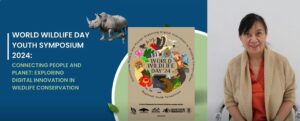Lunar New Year is a widely observed holiday in Southeast Asia, marked by colourful and vibrant festivities. This year is the “Year of the Wood Dragon,” represented by the most powerful among the 12 animals in Chinese mythology. Combined with the element of wood symbolising vitality, growth, and kindness, it is said that this year is expected to bring opportunities and changes, and is a favourable year for exploring new collaborations and partnerships. As such, we are hoping that this will be a fantastic year for all of us at the ASEAN Centre for Biodiversity (ACB), to continue facilitating regional cooperation in conserving our web of life, including the ‘dragons’ of ASEAN.
Real-life ‘dragons’ of Southeast Asia
Dragons are featured prominently in mythology, folklore, and many cultures across the world. These magical creatures are often described as huge, winged, serpent-like, and fire-breathing beasts. Though these mystical beings inhabit the realm of fantasy, there are real-life “dragons” that are just as fascinating as the legendary ones. Like the dragons of lore, these animals are the four-legged, cold-blooded, reptiles—the lizards.
There is a wide variety of lizards in Southeast Asia that are found nowhere else in the world. The most popular among them are Indonesia’s Komodo Dragons (Varanus komodoensis), the Philippine Sailfin Dragons (Hydrosaurus pustulatus), Sulawesi Lined Gliding Lizards (Draco spilonotus) and Borneo (Draco volans), and the recently discovered Khammouan Karst Dragon (Laodracon carsticola) from Lao PDR. Lizards perform important ecological functions such as seed dispersal, control of insect populations, and are vital food sources for different animals. Learn about these unique ASEAN species that exemplify the region’s biological diversity.
 Komodo Dragon (Varanus komodoensis)
Komodo Dragon (Varanus komodoensis)
Living off the coast of Indonesia’s Lesser Sunda Islands known as Komodo National Park, Komodo Dragons are the largest of all lizards, measuring about 10 feet long and typically weighing up to 154 pounds. Komodo Dragons can thrive in severe climate conditions and can live up to 30 years. Although they can be seen on islands, these carnivores or meat-eaters, prefer to stay in the tropical forests of the islands. They have long tails, can swim, and can even run as fast as 19 kilometres per hour. Compared to other reptiles, they only have a small population and are only found in five islands in Indonesia. They help prevent the spread of diseases by eating carcasses, thus promoting the overall health of the ecosystem. With the establishment of patrols and increased community understanding of the need to protect these species, the Indonesian government has improved ecotourism practices at Komodo National Park, thereby strengthening the conservation of these dragons.
Philippine Sailfin Lizard (Hydrosaurus pustulatus). Photo by: Jason Fernandez
Philippine Sailfin Lizards (Hydrosaurus pustulatus) are also called the Philippine Sailfin Dragons, which belong to the large semiaquatic lizard species called agamid which are a close relative of the iguanas. Agamid lizards have scaly bodies, well-developed legs, and moderately long tails. Some agamid lizards can also change colours to regulate their body temperatures. They can be found in all major islands of the country, except Palawan Island. They have large crests on their backs that look like sails, and they can grow to as much as four feet long. Like Komodo Dragons, Philippine Sailfin Dragons are strong swimmers, and smaller juvenile lizards can run briefly on the water’s surface. They are omnivores or they can eat both plants and meat. They live in areas with dense vegetation along the coasts and near rivers, riverbanks, lakes, mangrove forests, and even in flooded rice fields that are close to natural forests. They go by several local names. In the Philippines, their Tagalog name is layagan or balubid while they are called ibid in the Visayan dialect.
Sulawesi Lined Gliding Lizard (Draco spilonotus). Photo by: Oleg Chernyshov
Sulawesi Lined Gliding Lizards (Draco spilonotus) are commonly found in forested areas of Sulawesi, an island in Indonesia. They are actually confined to that island, particularly in Northern Sulawesi’s Tangkoko National Park. As medium-sized lizards, their length is usually 5–10 centimetres. They can survive hot and dry climates and can camouflage. The males have a pair of patagium or ‘wings’, that are yellow with brown lines. A patagium is a web of skin that connects the limbs to the body of the lizard, which helps them to glide from one tree to another. Males have a round-shaped and yellow-coloured skin flap that looks like a flag attached to their neck called gular flag, which is their main means of communicating with other lizards, most especially in attracting females. Draco lizards live in trees and they feed on ants and termites.
Common flying dragon (Draco volans). Photo by: Arnaud Delberghe
Common flying dragons (Draco volans) or Javan Flying Dragons are well adapted to live in trees, which is why they are called arboreal lizards. They can only be found in the rainforests of Southeast Asia especially in densely wooded habitats. They grow to a length of up to 22 centimeters including the tail, and the body is tan in colour with dark flecks. The ‘wings’ of males are coloured tan to bright orange with dark banding; in females, the flaps have irregular markings rather than banding. Like most Draco lizards, this species mainly eats ants and termites. They move from tree to tree not just to hunt for food and to attract mates, but also to escape from possible danger.
Green Crested Lizard (Bronchocela cristatella)
Green Crested Lizard (Bronchocela cristatella) can be found in Myanmar, Thailand, Malaysia, Singapore, the Philippines, and Indonesia. Coloured bright green and sometimes possessing a blue tint on the head, it can change its colour from light green to darker brown when threatened. Its body length is measured 13 centimetres, while the total length including the tail is 57 centimetres, with its tail making up 75 per cent of its total length. They live in primary and secondary forests but can also be found in parks, gardens, and in many habitats in rural areas. The males have an attractive neck crest. In Singapore, the population of B. cristatella is declining due to their competition with the changeable lizards (Calotes versicolor), an introduced species and is considered an invasive alien species in some countries of the ASEAN and is considered an invasive alien species in some countries of the ASEAN.

Giant Forest Dragon (Gonocephalus grandis) Photo by: Bernard Dupont
Giant Forest Dragon (Gonocephalus grandis) or Malayan Crested Lizard are found in Indonesia, Malaysia, Myanmar, Thailand, and Viet Nam. Adult males have large and pointed green-coloured crests on their neck and back and with a blue and yellow pattern on the sides of their bodies. Adult females, on the other hand, have similar colours but without the green crests. Interestingly, these lizards can change their colour from green to black in minutes. They belong to the family of agamid lizards or the kind that have long tails and well-developed muscular legs. In fact, these lizards are agile and can run quite fast on the forest floor or when climbing up on tree trunks.
Dragon Lizards (Laodracon carsticola). Photo by: Nathanael Maury
Finally, a new species of lizard was recently found in a limestone landscape in Khammouan Province, Lao PDR. Dragon Lizards (Laodracon carsticola) or commonly called Khammouan Karst Dragon, have a slight resemblance to the fictional dragons and belong to the Agamidae family—the kind of lizards that usually inhabit warmer environments. They eat ants and have outstanding capability to camouflage themselves. Their black and greyscale patterns match the limestone rocks and outcrops upon which they climb; and unless they move, it is impossible to detect them. These lizards are approximately 15 centimetres in length, have blue or grey eyes and some red and blue spots, and rough skin, which helps them climb on coarse rocks. Limestone karst formations such as karst towers, caves, and sinkholes, are important habitats for dragon lizards and also for many other unique species in the ASEAN.
More sustained and coordinated efforts on the conservation of natural environments where these lizards live would certainly lead to the protection of these unique species, some of which are known from small and fragmented populations. Raising awareness of the need to safeguard these ASEAN dragons is also essential, as they are crucial allies in protecting people against dangerous zoonotic diseases and in maintaining a balanced and well-functioning ecosystem.
Happy Year of the Dragon!























